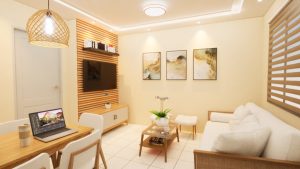Space matters, but how we use it matters more. A home entertainment zone isn’t about luxury it’s about intent. You want to watch, listen, play and unwind, without overspending. Building that space doesn’t require a giant screen, designer furniture or top-of-the-line gear. It just needs a plan.
This is how you do it, piece by piece with real, usable advice for a practical setup that works.
How to Create a Home Entertainment Zone?
Pick the Room and Lock the Layout

Start with what you have, whether that is a spare bedroom, a section of your lounge or the corner of a basement. Define the perimeter. You’re not redesigning your house, you’re allocating space.
Make sure you measure everything, including wall to wall, ceiling height, where the windows are, where the light comes in and where the sockets are.
Take note of it all. Sketch it if you need to. A layout saves you from expensive mistakes later, such as buying a speaker set that won’t fit, or placing a screen where glare wrecks the picture.
Once you’ve claimed the space, decide what it will do. Is this mainly for watching movies? Casual gaming? Sports? Music? Or maybe it’s a mix.
That will affect what you put where. How would you design it wood finishes, marble textures or something sleeker like a frameless design?
Screens: Go for Fit, Not Size
You don’t need the biggest screen, instead you need one that fits. A 50-inch TV in a small room feels overwhelming, while a projector in the wrong room looks washed out.
Budget-friendly 4K TVs from brands such as TCL or Hisense offer decent visuals and HDMI ports for external devices. Look for a screen that suits your viewing distance.
As a rough guide, 1.5 times the diagonal screen size gives you an ideal distance, so a 50-inch TV should be viewed from around six feet away.
If you prefer a projector, check the lumen rating. Anything under 2,000 lumens won’t cut it in a lit room. Don’t waste money on unnecessary “cinema mode” gimmicks, instead focus on native resolution and brightness.
Mount the screen as wall mounting frees up space. Cable management can hide clutter. Use brackets that tilt, so you can adjust the angle without moving the furniture.
Audio: Better Sound, Better Space
Sound isn’t about volume, it’s about clarity. Skip the giant surround systems unless your space can carry it. For most people, a soundbar with a subwoofer is more than enough. If you’re aiming for immersion, position two small bookshelf speakers at ear height, angled inward.
Aim to put soft materials in the room, such as carpets, curtains and cushions as sound behaves better that way, with less echo and better balance.
Avoid Bluetooth-only systems as latency can be a real issue. Use wired connections when you can as they’re stable, consistent and cheaper in the long run. If you’re watching or playing something that depends on audio timing, like rhythm games or action films, it makes a difference.
Furniture: Don’t Overfill
Use what you already have before buying anything new. You don’t need theatre seating. One or two comfortable chairs and maybe a beanbag or a couch with decent back support will be enough.
If you want something multi-purpose, go for modular units, such as sofas that convert to recliners and ottomans that double as storage boxes. Keep it practical.
Avoid clutter as every extra object adds visual noise. The more you pack in, the less you enjoy the space.
Set up seating based on screen height and audio positioning, not the other way around. You’re creating a triangle with the screen, seat and speaker. Keep that triangle clean.
Lighting: Keep It Under Control

Light affects everything, including how you see the screen, how your eyes feel and how long you can sit comfortably. Start by controlling outside light by using blackout curtains or thick blinds.
Then add indirect lighting such as LED strips behind the screen to reduce eye strain and table lamps or floor lights in corners to add warmth without glare.
Use smart bulbs if you can and set them to warm white. Avoid overhead spots and bright white light facing the screen. The goal is comfort, not brightness.
If you want mood lighting, use-coloured LEDs, but sparingly. Stick to one colour and one zone as anything more becomes a distraction.
Gaming and Interactive Features
If you play games, consider latency, input lag and viewing angles. Sit straight-on and use wired connections where possible as game controllers, consoles and monitors all work better when there’s less delay.
For digital games, especially interactive slots or live games, platforms such as AskGamblers can help you explore without commitment. Their reviews break down mechanics and themes, which is useful when setting up a casual gaming area.
If you’re using this zone to explore different forms of play, puzzle games, simulations and even slot-style games can provide stress relief. This gives you a central resource to figure out what’s worth your time.
Stick to one system. Don’t switch between console and PC and handheld and mobile. Choose one and build around it.
Final Words: Use the Space Often
A home entertainment zone isn’t a showroom. It’s not for guests it’s for you. Set it up so you can use it daily. You don’t need to impress anyone, instead, you need a space that works. Where the sound is good, the screen is clear and you know exactly where everything is.
Use it, tweak it and sit in it every night. Let it become part of your home.






